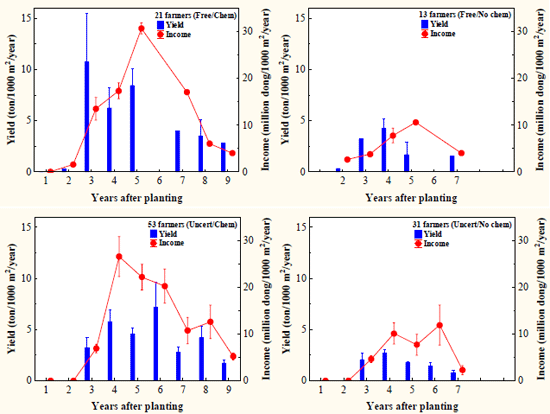Economic efficiency of the combination of planting disease‑free seedlings with application of systemic insecticides for the Citrus Greening problem in the Mekong Delta Region
Description
Citrus Greening disease (referred to as CG hereinafter), or Huanglongbing, is currently one of the most serious problems facing citrus farmers worldwide, since it results in destructive damage to citrus production only a few years after its invasion. There is no decisive control method for this disease. The most practical management considered at this moment is the combination of removal of all rutaceous trees in and around orchards, planting of new disease‑free seedlings, and application of systemic insecticides thereafter. The effectiveness of this management has not been proved, and it will take a long time to study its management in the field. However, circumstantial evidence of its effectiveness has been obtained by a questionnaire on the relationship between farmers’ management of citrus orchards and crop yields in each orchard. Our hypothesis was that crop yields in orchards where disease‑free seedlings have been planted and systemic insecticides applied are higher than in other orchards where neither of these managements was undertaken.
We randomly selected 116 farmers in the Mekong Delta Region of Vietnam and asked them if they used disease-free seedlings with or without systemic insecticide. We also asked them how much they invested financially in their orchards and the income from the crop yield. To examine the above hypothesis, we compared the results between management with disease‑free seedlings and systemic insecticide with other types of management and evaluated the effectiveness of our combination against the citrus greening problem.
We identified four management patterns of citrus cultivation according to combination of seedlings and systemic insecticides: the use of both disease‑free seedlings certified by a public organization and systemic insecticide (Free/Chem), disease‑free and no systemic insecticides (Free/No), seedlings without any certification (uncertified seedlings) but the use of systemic insecticides (Uncert/Chem), and uncertified and no systemic (Uncert/No chem). In the studied area, our estimates suggest that CG reduced crop yield by 10.3 % in the Free/Chem orchards, 16.1 % in the Free/No chem orchards, 14.5 % in the Uncert/Chem orchards, and 28.5 % in the Uncert/No chem orchards, compared to the crop yield in the absence of CG.
We define the economic durability of an orchard as the period in which farmers can expect an income of more than 300,000 dong/1000 m2 from the orchard after planting seedlings. The economic durability of orchards was five to six years without the use of systemic insecticide and seven to eight years with it, while fruit production started the third year after planting in both cases (Fig. 1). Mean annual yield during the economic durability period was 1.758 ± 0.342 (ton/1000 m2) in the Free/Chem orchards, 0.730 ± 0.142 in the Free/No chem orchard, 1.150 ± 0.255 in the Uncert/Chem orchard, 0.588 ± 0.128 in the Uncert/No chem orchard.
Mean annual investment (million dong/1000 m2) by each management type is shown in the Table 1. Naturally, investments in the purchase of seedlings and pesticides were the highest in the Free/Chem orchard. Investment in fertilizer was also fairly high in the management of systemic insecticide, while that in labor was similar among the four managements.
Our study revealed that although management that combines the planting of disease‑free seedlings with use of systemic insecticides required the highest monetary investment, it promises both the highest yield and income. However, our study is inevitably impeded by statistical problems. In this present study, we were not able to analyze either the effects of differences in geographic/weather conditions between fields/years or those due to variation in management styles undertaken by farmers. We need to perform field experiments in which these conditions are included. This is a future issue.
Figure, table
-
Fig. 1.
Mean annual yield of crop and income by the four separate types of citrus management, categorized according to combination of disease‑free seedling and systemic insecticide (cf. text for the definition of the managements). -
Table 1.
Mean annual investment (± SD) by the four separate management types of citrus, according to combination of disease‑free seedling and systemic insecticide.
- Affiliation
-
Japan International Research Center for Agricultural Sciences Okinawa Subtropical Station
- Classification
-
Technical A
- Term of research
-
FY2005(FY2004~2008)
- Responsible researcher
-
TIEN Doan Huu ( Southern Fruit Research Institute )
KANO Takeshi ( Okinawa Subtropical Station )
ICHINOSE Katsuya ( Okinawa Subtropical Station )
YAMADA Ryuich ( Okinawa Subtropical Station )
- ほか
- Publication, etc.
-
Ichinose, K. and Kano, T. (2006) Plant Protection 60(7):302-307
- Japanese PDF
-
2005_seikajouhou_A4_ja_Part22.pdf488.37 KB


